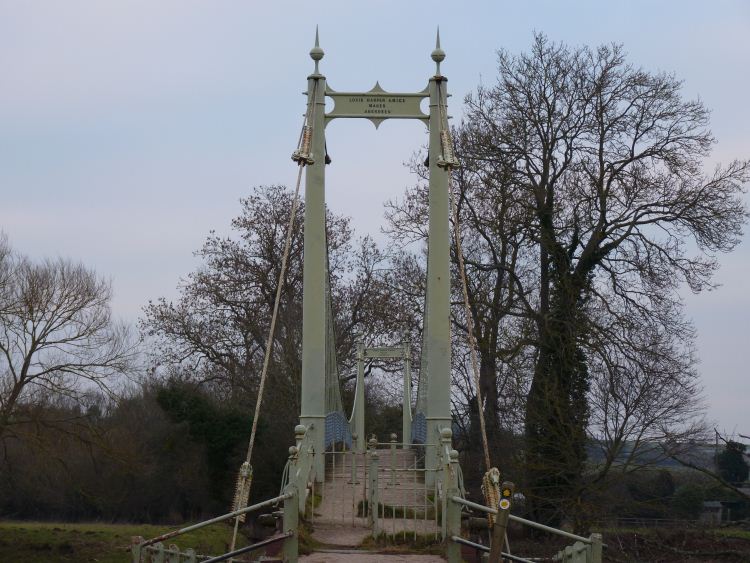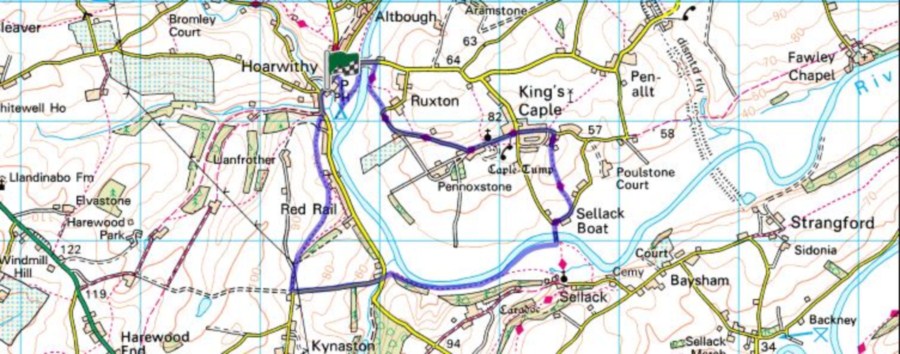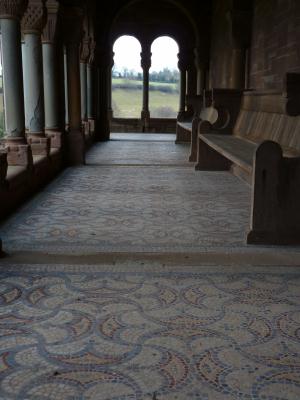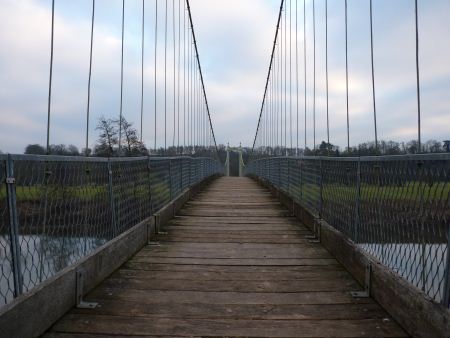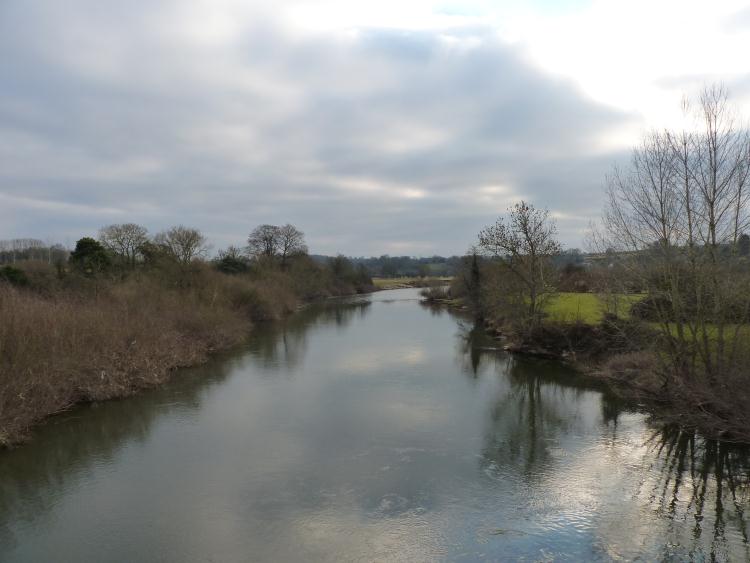This is a relatively short circular walk which provides interesting insights into rural life in Herefordshire over the last 150 years.
- Grade: Easy – The walking is mostly on the level or relatively gentle slopes, although there is on uphill ‘drag’ on an asphalt road
- Length: 4 miles
- Key Features: Hoarwithy, Kings Caple and Sellack Churches, with a pedestrian suspension bridge over the Wye at Sellack.
- Refreshments: New Harp Inn
For an interactive version of this map click the image above or here
Route
This walk starts in Hoarwithy (with the first church). Take the footpath to the left of the New Harp Inn, when you’re facing the Inn. Go through the camping field, and turn left at the botto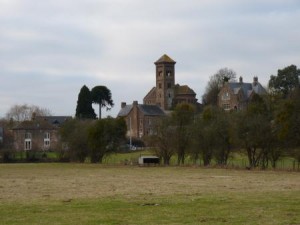 m following the yellow arrows.
m following the yellow arrows.
Continue following the arrows, until you come close to the road where you take the steps which are to the left of an old toll house, and then take the bridge to the right across the river. A few yards after the bridge, and just before the sign for the village of Kings Caple take the bridleway to the right.
Continue along this bridle path, ignoring a footpath sign on the left. After about ¼ mile you get to and asphalted road, where you continue in the same direction of travel as the bridle path. You will go past St. John’s church in Kings Caple (second church), until you reach a crossroads where you go straight on.
Just as you’re leaving the village you will see a footpath to the right, which you take down an asphalted lane which changes fairly quickly into a farm track. Follow the yellow arrows, until you reach another asphalted lane where you go right.
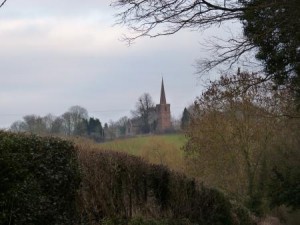 Where this lane turns sharply round to the right, you take the path which is signposted to the left. This takes you down to the river, where you go across the pedestrian suspension bridge ( the ‘bridge’ in the name of the walk) looking out for Sellack church ( third church) straight ahead of you, and then turn right along the river bank.
Where this lane turns sharply round to the right, you take the path which is signposted to the left. This takes you down to the river, where you go across the pedestrian suspension bridge ( the ‘bridge’ in the name of the walk) looking out for Sellack church ( third church) straight ahead of you, and then turn right along the river bank.
Eventually this resolves into a track which soon curves steeply to the left, taking you up to the main road, over a stile. Go across the road and take the smaller lane opposite signposted to Kynaston.
Walk up the long slow drag of the hill, until just past the crest you’ll find a track signposted to the right which you take. Very soon you will see a pylon in front of you, and you want to take the path to the right of this, fairly steeply downhill between two earth bunds on each side. You then go over a stile, and continue straight ahead keeping to the top of the field.
Follow the yellow arrows for some distance, until you come to a wooded section with some stiles, after which you will soon emerge onto a lane. You go across this, taking the path to the left of a house called Quarry Bank, which will take you towards the main road, and when you emerge on this you turn left to Hoarwithy.
The walk
We had a look at Hoarwithy church before we began to walk. It’s built in the Italian style (apparently a 19th century vicar decided that the original building was ugly, and set about making it look rather more exotic) and as you’re walking towards it you can easily forget that the skies are grey and British, and think they are deep blue and Tuscan.
In many ways as you get nearer this impression is confirmed, because like many Italian somewhat neglected churches, this is gently crumbling away. In fact, to get to the main entrance you have to go past ‘beware of falling masonry’ signs. Here, as well as the crumbling masonry, you’ll find tiled floors, and be tempted to look for Italian vistas through the arches – unfortunately at the time of the year we were looking the actual vistas were rather different.
Inside, in the lobby, there seemed to be a Moroccan influence – particularly with the lights. You have to go yourself and have a look, because it is a most unexpected find in the Herefordshire countryside.
Ironically, having been reminded of intense sunshine and warm stone, our walk began in a bitterly cold wind – the sort that makes you feel as though the skin on your face might freeze and fall away. Despite the coldness, throughout the walk we saw brave signs of spring, tiny tender twin green leaves emerging through the detritus of winter.
The next two churches are solid English ones at King’s Caple and Sellack. As you walk from one to the other you go over a very elegant pedestrian suspension bridge. The history of this was recounted in an exhibition in Sellack Church:-
“‘Not all was peace and jollity however – with King’s Caple a daughter church to Sellack, it was not always easy for the vicar, who lived in Sellack, to reach the other village. Originally a ford and then later a ferry, the crossing could be difficult.
‘The boathouse, the residence of the ferryman, (the family name was Harris) is still on the King’s Caple side. Certain boatmen could be very awkward (and often were), refusing to take the vicar across! (One cleric is reported to have frequently crossed the river on stilts). This continued strife caused much local outcry and resulted in a public petition for a bridge to be built. This was finally done due in main to the energies of the Rev Augustin Ley (1877-1908) and largely at his expense! A fine suspension bridge. Under the bridge is a stone built into the buttress with the inscription – ‘To the honour of God and the lasting union of these parishes’.”
The bridge itself is elegant – and apparently “This is the finest example of a Louis Harper bridge still in use in the UK. It has tapered tubular cast iron pylons, and is of width 4 feet.” ( if you want to know more about this type of bridge click here)
The views from the bridge are gentle, rolling and reflective – although the gathering of swans we could see on the bank were probably more concerned about the rawness of the wind.


 Wye Walker
Wye Walker 